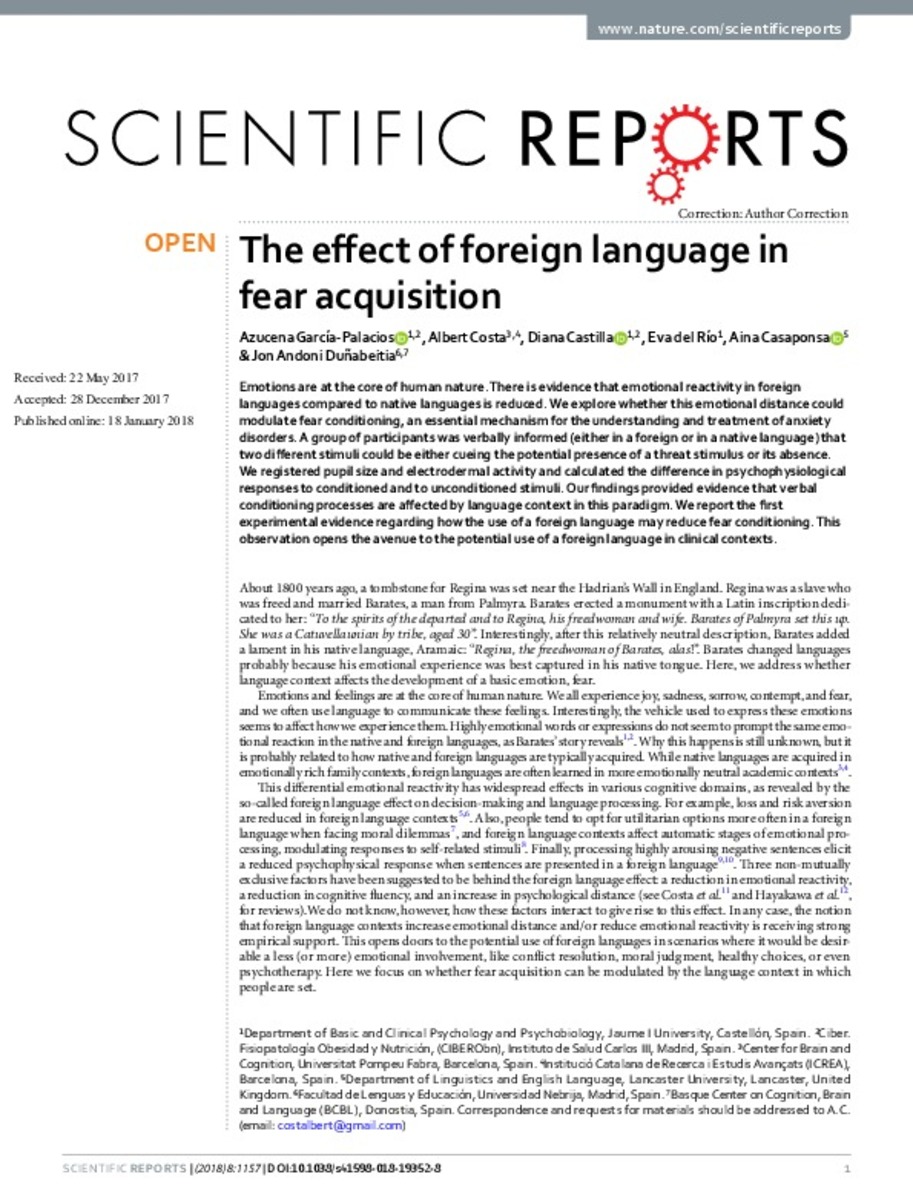Mostrar el registro sencillo del ítem
The effect of foreign language in fear acquisition
| dc.contributor.author | Díaz-García, Amanda | |
| dc.contributor.author | Costa, Albert | |
| dc.contributor.author | Castilla, Diana | |
| dc.contributor.author | Río González, Eva del | |
| dc.contributor.author | Casaponsa, Aina | |
| dc.contributor.author | Duñabeitia, Jon Andoni | |
| dc.date.accessioned | 2018-05-15T17:49:15Z | |
| dc.date.available | 2018-05-15T17:49:15Z | |
| dc.date.issued | 2018 | |
| dc.identifier.citation | GARCÍA-PALACIOS, Azucena, et al. The effect of foreign language in fear acquisition. Scientific reports, 2018, vol. 8, núm.1, p.1157. | ca_CA |
| dc.identifier.issn | 2045-2322 | |
| dc.identifier.uri | http://hdl.handle.net/10234/174691 | |
| dc.description.abstract | Emotions are at the core of human nature. There is evidence that emotional reactivity in foreign languages compared to native languages is reduced. We explore whether this emotional distance could modulate fear conditioning, an essential mechanism for the understanding and treatment of anxiety disorders. A group of participants was verbally informed (either in a foreign or in a native language) that two different stimuli could be either cueing the potential presence of a threat stimulus or its absence. We registered pupil size and electrodermal activity and calculated the difference in psychophysiological responses to conditioned and to unconditioned stimuli. Our findings provided evidence that verbal conditioning processes are affected by language context in this paradigm. We report the first experimental evidence regarding how the use of a foreign language may reduce fear conditioning. This observation opens the avenue to the potential use of a foreign language in clinical contexts. | ca_CA |
| dc.format.extent | 8 p. | ca_CA |
| dc.format.mimetype | application/pdf | ca_CA |
| dc.language.iso | eng | ca_CA |
| dc.publisher | Nature Publishing Group | ca_CA |
| dc.relation.isPartOf | Scientific reports, 2018, vol. 8, núm. 1, p. 1157 | ca_CA |
| dc.rights | Open Access This article is licensed under a Creative Commons Attribution 4.0 International License, which permits use, sharing, adaptation, distribution and reproduction in any medium or format, as long as you give appropriate credit to the original author(s) and the source, provide a link to the Cre- ative Commons license, and indicate if changes were made. The images or other third party material in this article are included in the article’s Creative Commons license, unless indicated otherwise in a credit line to the material. If material is not included in the article’s Creative Commons license and your intended use is not per- mitted by statutory regulation or exceeds the permitted use, you will need to obtain permission directly from the copyright holder. To view a copy of this license, visit http://creativecommons.org/licenses/by/4.0/ . © The Author(s) 2018 | ca_CA |
| dc.rights | Atribución 4.0 Internacional | * |
| dc.rights.uri | http://creativecommons.org/licenses/by-sa/4.0/ | * |
| dc.subject | cognitive neuroscience | ca_CA |
| dc.subject | neuroscience | ca_CA |
| dc.title | The effect of foreign language in fear acquisition | ca_CA |
| dc.type | info:eu-repo/semantics/article | ca_CA |
| dc.identifier.doi | https://doi.org/10.1038/s41598-018-19352-8 | |
| dc.relation.projectID | We would like to thank Dr. Miguel F. Ruiz-Garrido and his colleagues from The Department of English Studies at Jaume I University and Irma Mulet and her colleagues of the Language and Terminology Service at Jaume I University for providing access to the students that participated in this study. We would also like to thank all the participants for their valuable collaboration. This research has been partially funded by grants PSI2015-65689-P and SEV-2015-0490 from the Spanish Government and AThEME-613465 from the European Union | ca_CA |
| dc.rights.accessRights | info:eu-repo/semantics/openAccess | ca_CA |
| dc.relation.publisherVersion | https://www.nature.com/articles/s41598-018-19352-8 | ca_CA |
| dc.type.version | info:eu-repo/semantics/publishedVersion | ca_CA |
Ficheros en el ítem
Este ítem aparece en la(s) siguiente(s) colección(ones)
-
PSB_Articles [1302]
Articles de publicacions periòdiques
Excepto si se señala otra cosa, la licencia del ítem se describe como: Open Access
This article is licensed under a Creative Commons Attribution 4.0 International
License, which permits use, sharing, adaptation, distribution and reproduction in any medium or
format, as long as you give appropriate credit to the original author(s) and the source, provide a link to the Cre-
ative Commons license, and indicate if changes were made. The images or other third party material in this
article are included in the article’s Creative Commons license, unless indicated otherwise in a credit line to the
material. If material is not included in the article’s Creative Commons license and your intended use is not per-
mitted by statutory regulation or exceeds the permitted use, you will need to obtain permission directly from the
copyright holder. To view a copy of this license, visit
http://creativecommons.org/licenses/by/4.0/
.
© The Author(s) 2018








